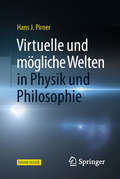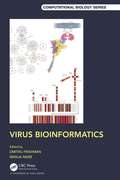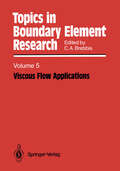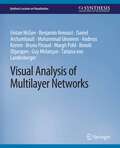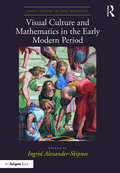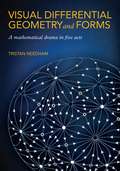- Table View
- List View
Virtual Work Approach to Mechanical Modeling
by Jean SalençonThis book is centred about the Principle of virtual work and the related method for mechanical modelling. It aims at showing and enhancing the polyvalence and versatility of the virtual work approach in the mechanical modelling process. The virtual work statement is set as the principle at the root of a force modelling method that can be implemented on any geometrical description. After experimentally induced hypotheses have been made on the geometrical parameters that describe the concerned system and subsystems, the method provides a unifying framework for building up consistently associated force models where external and internal forces are introduced through their virtual rates of work. Systems described as three-dimensional, curvilinear or planar continua are considered: force models are established with the corresponding equations of motion; the validation process points out that enlarging the domain of relevance of the model for practical applications calls for an enrichment of the geometrical description that takes into account the underlying microstructure.
Virtual Work Approach to Mechanical Modeling
by Jean SalençonThis book is centred about the Principle of virtual work and the related method for mechanical modelling. It aims at showing and enhancing the polyvalence and versatility of the virtual work approach in the mechanical modelling process. The virtual work statement is set as the principle at the root of a force modelling method that can be implemented on any geometrical description. After experimentally induced hypotheses have been made on the geometrical parameters that describe the concerned system and subsystems, the method provides a unifying framework for building up consistently associated force models where external and internal forces are introduced through their virtual rates of work. Systems described as three-dimensional, curvilinear or planar continua are considered: force models are established with the corresponding equations of motion; the validation process points out that enlarging the domain of relevance of the model for practical applications calls for an enrichment of the geometrical description that takes into account the underlying microstructure.
Virtuelle und mögliche Welten in Physik und Philosophie
by Hans J. PirnerWas sind mögliche Welten und was haben Entwicklungen der modernen Physik mit Ideen über mögliche Welten in der Philosophie zu tun? In der Beantwortung dieser Fragen entwickelt das vorliegende Werk das wissenschaftliche Weltbild im Vergleich mit möglichen Welten und gelangt so zu einem besseren Verständnis unserer einzigen wirklichen Welt. Dazu beschreibt der Autor die kreativen Ideen, die zur klassischen Physik, zur Quantenphysik und zur Erforschung des Ursprungs des Weltalls geführt haben. Er lädt den Leser ein, mit ihm über die Versuche in der modernen Physik nachzudenken, Parallelwelten und neue Universen einzuführen. Man erfährt, wie in Physik und Philosophie mögliche Welten als Instrumente verwendet werden, um unsere Erkenntnisse zu erweitern. Es wird erläutert, wie man sich mögliche Welten auch außerhalb der Physik vorzustellen hat und welchen Anforderungen diesen genügen. Unter diesem Gesichtspunkt analysiert der Autor abschließend die Zukunftsvisionen der Science-Fiction Literatur und die neuesten Erkenntnisse über künstliche, virtuelle und hybride Welten. Anhänge mit vertieftem physikalischen Hintergrund und ein ausführliches Glossar unterstützen die interessierten Lesern und Leserinnen dabei, einen Überblick über die vielfältigen Begriffe und Sachverhalte zu behalten.
Virus Bioinformatics (Chapman & Hall/CRC Computational Biology Series)
by Dmitrij Frishman Manja MarzViruses are the most numerous and deadliest biological entities on the planet, infecting all types of living organisms—from bacteria to human beings. The constantly expanding repertoire of experimental approaches available to study viruses includes both low-throughput techniques, such as imaging and 3D structure determination, and modern OMICS technologies, such as genome sequencing, ribosomal profiling, and RNA structure probing. Bioinformatics of viruses faces significant challenges due to their seemingly unlimited diversity, unusual lifestyle, great variety of replication strategies, compact genome organization, and rapid rate of evolution. At the same time, it also has the potential to deliver decisive clues for developing vaccines and medications against dangerous viral outbreaks, such as the recent coronavirus pandemics. Virus Bioinformatics reviews state-of-the-art bioinformatics algorithms and recent advances in data analysis in virology. FEATURES Contributions from leading international experts in the field Discusses open questions and urgent needs Covers a broad spectrum of topics, including evolution, structure, and function of viruses, including coronaviruses The book will be of great interest to computational biologists wishing to venture into the rapidly advancing field of virus bioinformatics as well as to virologists interested in acquiring basic bioinformatics skills to support their wet lab work.
Virus Bioinformatics (Chapman & Hall/CRC Computational Biology Series)
by Dmitrij Frishman Manja MarzViruses are the most numerous and deadliest biological entities on the planet, infecting all types of living organisms—from bacteria to human beings. The constantly expanding repertoire of experimental approaches available to study viruses includes both low-throughput techniques, such as imaging and 3D structure determination, and modern OMICS technologies, such as genome sequencing, ribosomal profiling, and RNA structure probing. Bioinformatics of viruses faces significant challenges due to their seemingly unlimited diversity, unusual lifestyle, great variety of replication strategies, compact genome organization, and rapid rate of evolution. At the same time, it also has the potential to deliver decisive clues for developing vaccines and medications against dangerous viral outbreaks, such as the recent coronavirus pandemics. Virus Bioinformatics reviews state-of-the-art bioinformatics algorithms and recent advances in data analysis in virology. FEATURES Contributions from leading international experts in the field Discusses open questions and urgent needs Covers a broad spectrum of topics, including evolution, structure, and function of viruses, including coronaviruses The book will be of great interest to computational biologists wishing to venture into the rapidly advancing field of virus bioinformatics as well as to virologists interested in acquiring basic bioinformatics skills to support their wet lab work.
Virus Host Cell Genetic Material Transport: Computational ODE/PDE Modeling with R
by William E. SchiesserThe reproduction and spread of a virus during an epidemic proceeds when the virus attaches to a host cell and viral genetic material (VGM) (protein, DNA, RNA) enters the cell, then replicates, and perhaps mutates, in the cell. The movement of the VGM across the host cell outer membrane and within the host cell is a spatiotemporal dynamic process that is modeled in this book as a system of ordinary and partial differential equations (ODE/PDEs). The movement of the virus proteins through the cell membrane is modeled as a diffusion process expressed by the diffusion PDE (Fick’s second law). Within the cell, the time variation of the VGM is modeled as ODEs. The evolution of the dependent variables is computed by the numerical integration of the ODE/PDEs starting from zero initial conditions (ICs). The departure of the dependent variables from zero is in response to the virus protein concentration at the outer membrane surface (the point at which the virus binds to the host cell). The numerical integration of the ODE/PDEs is performed with routines coded (programmed) in R, a quality, open-source scientific computing system that is readily available from the Internet. Formal mathematics is minimized, e.g., no theorems and proofs. Rather, the presentation is through detailed examples that the reader/researcher/analyst can execute on modest computers. The ODE/PDE dependent variables are displayed graphically with basic R plotting utilities. The R routines are available from a download link so that the example models can be executed without having to first study numerical methods and computer coding. The routines can then be applied to variations and extensions of the ODE/PDE model, such as changes in the parameters and the form of the model equations.
Viscoelastic Interfaces Driven in Disordered Media: Applications to Friction (Springer Theses)
by François P. LandesThis book offers an in-depth study of two well-known models of “avalanche” dynamics, modified minimally by the inclusion of relaxation. Many complex systems respond to continuous inputs of energy by accumulation of stress over time, interrupted by sudden energy releases called avalanches. The first model studied is the viscoelastic interface driven over disorder, which is shown to display the fundamental features of friction. In the mean-field limit, the friction force derived semi-analytically is compatible with laboratory experiments (displaying both velocity weakening and contact aging). In two dimensions, large-scale numerical simulations are in good agreement with the basic features of real earthquakes (Gutenberg-Richter Law, aftershock migration). The second model is a non-Markovian variant of Directed Percolation, in which we observe that the universality class is only partly modified by relaxation, a promising finding with respect to our first model.
Viscosity Solutions and Applications: Lectures given at the 2nd Session of the Centro Internazionale Matematico Estivo (C.I.M.E.) held in Montecatini Terme, Italy, June, 12 - 20, 1995 (Lecture Notes in Mathematics #1660)
by Martino Bardi Michael G. Crandall Lawrence C. Evans Halil M. Soner Panagiotis E. SouganidisThe volume comprises five extended surveys on the recent theory of viscosity solutions of fully nonlinear partial differential equations, and some of its most relevant applications to optimal control theory for deterministic and stochastic systems, front propagation, geometric motions and mathematical finance. The volume forms a state-of-the-art reference on the subject of viscosity solutions, and the authors are among the most prominent specialists. Potential readers are researchers in nonlinear PDE's, systems theory, stochastic processes.
Viscous Flow Applications (Topics in Boundary Element Research #5)
by Carlos A. BrebbiaThe Boundary Element Method has now become a powerful tool of engineering analysis and is routinely applied for the solution of elastostatics and potential problems. More recently research has concentrated on solving a large variety of non-linear and time dependent applications and in particular the method has been developed for viscous fluid flow problems. This book presents the state of the art on the solution of viscous flow using boundary elements and discusses different current approaches which have been validated by numerical experiments. . Chapter 1 of the book presents a brief review of previous work on viscous flow simulation and in particular gives an up-to-date list of the most important BEM references in the field. Chapter 2 reviews the governing equations for general viscous flow, including compressibility. The authors present a compre hensive treatment of the different cases and their formulation in terms of boundary integral equations. This work has been the result of collaboration between Computational Mechanics Institute of Southampton and Massa chusetts Institute of Technology researchers. Chapter 3 describes the gen eralized formulation for unsteady viscous flow problems developed over many years at Georgia Institute of Technology. This formulation has been extensively applied to solve aer09ynamic problems.
Viscous Flows: Stretching and Shrinking of Surfaces (Mathematical Engineering)
by Ahmer MehmoodThis authored monograph provides a detailed discussion of the boundary layer flow due to a moving plate. The topical focus lies on the 2- and 3-dimensional case, considering axially symmetric and unsteady flows. The author derives a criterion for the self-similar and non-similar flow, and the turbulent flow due to a stretching or shrinking sheet is also discussed. The target audience primarily comprises research experts in the field of boundary layer flow, but the book will also be beneficial for graduate students.
The Visible Hand: Synergetic Microfoundation of Macroeconomic Dynamics (Lecture Notes in Economics and Mathematical Systems #369)
by Reiner B. KobloIn the last decade highly innovatory developments have taken place in theoretical economics. The new focus of interest seems to be twofold: Firstly, nonlinear models for dynamic processes of the economy are constructed to extend the scope of linear models for tlle stationary euqilibrium state; and secondly a new approach is made to solve the everlasting problem of the relation between micro-and macro-economics. The interdisciplinary field of synergetics is deeply involved in this evolution. The author has made a remarkable contribution to both foci: His application of synergetic concepts to the theory of business cycles combines a partial solution of the micro-macro-problem, namely the modelling of the macro-economic effect of the decisions of investors, producers and consumers, with the natural introduction of nonlinearities. The arising new business cycle theory can on the one side be validated by empirical evidence and on the other hand the typical behavior of nonlinear dynamic systems including the transition to deterministic chaos can be clearly demonstrated. The hope is justified that the model presented in this book is a fw·ther important step in reaching a new level of the quantitative comprehension of dynamic phenomena in the economy. Stuttgart, June 1991 Prof. Dr. Wolfgang Weidlich Foreword It is the author's objective to explain macroeconomic processes on the basis of micro economic decision-making behaviour. In order to achieve this goal, the concept of synergetics is presented as a method of describing dynamic phenomena in multi-com ponent systems with cooperative interactions between their elements.
Visible Maths: Using representations and structure to enhance mathematics teaching in schools
by Peter MattockPeter Mattock’s Visible Maths: Using representations and structure to enhance mathematics teaching in schools supports teachers in their use of concrete and pictorial representations to illustrate key mathematical ideas and operations.Viewing the maths lesson as an opportunity for pupils to develop a deep understanding of mathematical concepts and relationships, rather than simply to follow fixed processes that lead to ‘the answer’, is increasingly recognised as the pinnacle of best practice in maths education.In this book, Peter Mattock builds on this approach and explores – in colourful detail – a variety of visual tools and techniques that can be used in the classroom to deepen pupils’ understanding of mathematical operations. Covering vectors, number lines, algebra tiles, ordered-pair graphs and many other representations, Visible Maths equips teachers with the confidence and practical know-how to take their pupils’ learning to the next level.The book looks at the strengths, and flaws, of each representation so that both primary and secondary school teachers of maths can make informed judgements about which representations will benefit their pupils. The exploration begins at the very basics of number and operation, and extends all the way through to how the representations apply to algebraic expressions and manipulations. As well as sharing his expert knowledge on the subject, Peter draws on relevant research and his own experience of using the representations in order to support teachers in understanding how these representations can be implemented effectively.Visible Maths also includes a glossary covering the key mathematical terms, as well as a chapter dedicated to answering some of the questions that may arise from the reading of the book. Furthermore, the accompanying diagrams and models are displayed in full colour to illustrate the conceptual takeaways and teaching techniques discussed.Suitable for teachers of maths in primary and secondary school settings.Chapters include: 1. Different representations of whole numbers; 2. Representing fractions and decimals; 3. Addition and subtraction with integers; 4. Multiplication and division of integers; 5. Powers and roots; 6. Operations with fractions and decimals; 7. Laws of arithmetic; 8. Order of operations; 9. Accuracy and numerical representations; 10. Representing irrational numbers; 11. Introducing algebra; 12. Simplifying algebraic expressions; 13. Multiplying algebraic expressions; 14. Expanding and factorising algebraic expressions; 15. Equations and representations; 16. Further algebraic manipulations; 17. Frequently asked and anticipated questions.Customer notice: this book contains a large amount of full colour images, therefore any digital version would be better rendered by being viewed using a device with a colour display.
Vision with Direction: A Systematic Introduction to Image Processing and Computer Vision
by Josef BigunImage analysis is a computational feat which humans show excellence in, in comp- ison with computers. Yet the list of applications that rely on automatic processing of images has been growing at a fast pace. Biometric authentication by face, ?ngerprint, and iris, online character recognition in cell phones as well as drug design tools are but a few of its benefactors appearing on the headlines. This is, of course, facilitated by the valuable output of the resarch community in the past 30 years. The pattern recognition and computer vision communities that study image analysis have large conferences, which regularly draw 1000 parti- pants. In a way this is not surprising, because much of the human-speci?c activities critically rely on intelligent use of vision. If routine parts of these activities can be automated, much is to be gained in comfort and sustainable development. The - search ?eld could equally be called visualintelligence because it concerns nearly all activities of awake humans. Humans use or rely on pictures or pictorial languages to represent, analyze, and develop abstract metaphors related to nearly every aspect of thinking and behaving, be it science, mathematics, philosopy, religion, music, or emotions. The present volume is an introductory textbook on signal analysis of visual c- putation for senior-level undergraduates or for graduate students in science and - gineering. My modest goal has been to present the frequently used techniques to analyze images in a common framework–directional image processing.
Visions in Mathematics: GAFA 2000 Special Volume, Part I pp. 1-453 (Modern Birkhäuser Classics)
by Noga Alon Jean Bourgain Alain Connes Misha Gromov Vitali D. Milman"Visions in Mathematics - Towards 2000" was one of the most remarkable mathematical meetings in recent years. It was held in Tel Aviv from August 25th to September 3rd, 1999, and united some of the leading mathematicians worldwide. The goals of the conference were to discuss the importance, the methods, the past and the future of mathematics as we enter the 21st century and to consider the connection between mathematics and related areas. The aims of the conference are reflected in the present set of survey articles, documenting the state of art and future prospects in many branches of mathematics of current interest. This is the first part of a two-volume set that will serve any research mathematician or advanced student as an overview and guideline through the multifaceted body of mathematical research in the present and near future.
Visions in Mathematics: GAFA 2000 Special Volume, Part II pp. 455-983 (Modern Birkhäuser Classics)
by Noga Alon Jean Bourgain Alain Connes Misha Gromov Vitali D. Milman"Visions in Mathematics - Towards 2000" was one of the most remarkable mathematical meetings in recent years. It was held in Tel Aviv from August 25th to September 3rd, 1999, and united some of the leading mathematicians worldwide. The goals of the conference were to discuss the importance, the methods, the past and the future of mathematics as we enter the 21st century and to consider the connection between mathematics and related areas. The aims of the conference are reflected in the present set of survey articles, documenting the state of art and future prospects in many branches of mathematics of current interest. This is the second part of a two-volume set that will serve any research mathematician or advanced student as an overview and guideline through the multifaceted body of mathematical research in the present and near future.
Visual Analysis of Behaviour: From Pixels to Semantics
by Shaogang Gong Tao XiangThis book presents a comprehensive treatment of visual analysis of behaviour from computational-modelling and algorithm-design perspectives. Topics: covers learning-group activity models, unsupervised behaviour profiling, hierarchical behaviour discovery, learning behavioural context, modelling rare behaviours, and “man-in-the-loop” active learning; examines multi-camera behaviour correlation, person re-identification, and “connecting-the-dots” for abnormal behaviour detection; discusses Bayesian information criterion, Bayesian networks, “bag-of-words” representation, canonical correlation analysis, dynamic Bayesian networks, Gaussian mixtures, and Gibbs sampling; investigates hidden conditional random fields, hidden Markov models, human silhouette shapes, latent Dirichlet allocation, local binary patterns, locality preserving projection, and Markov processes; explores probabilistic graphical models, probabilistic topic models, space-time interest points, spectral clustering, and support vector machines.
Visual Analysis of Multilayer Networks (Synthesis Lectures on Visualization)
by Fintan McGee Benjamin Renoust Daniel Archambault Mohammad Ghoniem Andreas Kerren Bruno PinaudThe emergence of multilayer networks as a concept from the field of complex systems provides many new opportunities for the visualization of network complexity, and has also raised many new exciting challenges. The multilayer network model recognizes that the complexity of relationships between entities in real-world systems is better embraced as several interdependent subsystems (or layers) rather than a simple graph approach. Despite only recently being formalized and defined, this model can be applied to problems in the domains of life sciences, sociology, digital humanities, and more. Within the domain of network visualization there already are many existing systems, which visualize data sets having many characteristics of multilayer networks, and many techniques, which are applicable to their visualization. In this Synthesis Lecture, we provide an overview and structured analysis of contemporary multilayer network visualization. This is not only for researchers in visualization, but also for those who aim to visualize multilayer networks in the domain of complex systems, as well as those solving problems within application domains. We have explored the visualization literature to survey visualization techniques suitable for multilayer network visualization, as well as tools, tasks, and analytic techniques from within application domains. We also identify the research opportunities and examine outstanding challenges for multilayer network visualization along with potential solutions and future research directions for addressing them.
Visual Analytics for Dashboards: A Step-by-Step Guide to Principles and Practical Techniques
by Arshad KhanThis book covers the key principles, best practices, and practical techniques for designing and implementing visually compelling dashboards. It explores the various stages of the dashboard development process, from understanding user needs and defining goals, to selecting appropriate visual encodings, designing effective layouts, and employing interactive elements. It also addresses the critical aspect of data storytelling, examining how narratives and context can be woven into dashboards to deliver impactful insights and engage audiences. Visual Analytics for Dashboards is designed to cater to a wide range of readers, from beginners looking to grasp the fundamentals of visual analytics, to seasoned professionals seeking to enhance their dashboard design skills. For different types of readers, such as a data analyst, BI professional, data scientist, or simply someone interested in data visualization, this book aims to equip them with the knowledge and tools necessary to create impactful dashboards. What you’ll learn The principles of data visualization How to create effective dashboards Meet all the requirements for visual analytics/data visualization/dashboard courses Deepen understanding of data presentation and analysis How to use different kinds of tools for data analysis, such as scorecards and key performance indicators Who This Book Is For Business analysts, data analysts, BI professionals, end-users, executives, developers, as well as students in dashboards, data visualizations, and visual analytics courses.
Visual Complex Analysis: 25th Anniversary Edition
by Tristan NeedhamComplex Analysis is the powerful fusion of the complex numbers (involving the 'imaginary' square root of -1) with ordinary calculus, resulting in a tool that has been of central importance to science for more than 200 years. This book brings this majestic and powerful subject to life by consistently using geometry (not calculation) as the means of explanation. The 501 diagrams of the original edition embodied geometrical arguments that (for the first time) replaced the long and often opaque computations of the standard approach, in force for the previous 200 years, providing direct, intuitive, visual access to the underlying mathematical reality. This new 25th Anniversary Edition introduces brand-new captions that fully explain the geometrical reasoning, making it possible to read the work in an entirely new way—as a highbrow comic book!
Visual Complex Functions: An Introduction with Phase Portraits
by Elias WegertThis book provides a systematic introduction to functions of one complex variable. Its novel feature is the consistent use of special color representations – so-called phase portraits – which visualize functions as images on their domains.Reading Visual Complex Functions requires no prerequisites except some basic knowledge of real calculus and plane geometry. The text is self-contained and covers all the main topics usually treated in a first course on complex analysis. With separate chapters on various construction principles, conformal mappings and Riemann surfaces it goes somewhat beyond a standard programme and leads the reader to more advanced themes.In a second storyline, running parallel to the course outlined above, one learns how properties of complex functions are reflected in and can be read off from phase portraits. The book contains more than 200 of these pictorial representations which endow individual faces to analytic functions. Phase portraits enhance the intuitive understanding of concepts in complex analysis and are expected to be useful tools for anybody working with special functions – even experienced researchers may be inspired by the pictures to new and challenging questions.Visual Complex Functions may also serve as a companion to other texts or as a reference work for advanced readers who wish to know more about phase portraits.
Visual Culture and Mathematics in the Early Modern Period (Visual Culture in Early Modernity)
by Ingrid Alexander-SkipnesDuring the early modern period there was a natural correspondence between how artists might benefit from the knowledge of mathematics and how mathematicians might explore, through advances in the study of visual culture, new areas of enquiry that would uncover the mysteries of the visible world. This volume makes its contribution by offering new interdisciplinary approaches that not only investigate perspective but also examine how mathematics enriched aesthetic theory and the human mind. The contributors explore the portrayal of mathematical activity and mathematicians as well as their ideas and instruments, how artists displayed their mathematical skills and the choices visual artists made between geometry and arithmetic, as well as Euclid’s impact on drawing, artistic practice and theory. These chapters cover a broad geographical area that includes Italy, Switzerland, Germany, the Netherlands, France and England. The artists, philosophers and mathematicians whose work is discussed include Leon Battista Alberti, Nicholas Cusanus, Marsilio Ficino, Francesco di Giorgio, Leonardo da Vinci and Andrea del Verrocchio, as well as Michelangelo, Galileo, Piero della Francesca, Girard Desargues, William Hogarth, Albrecht Dürer, Luca Pacioli and Raphael.
Visual Culture and Mathematics in the Early Modern Period (Visual Culture in Early Modernity)
by Ingrid Alexander-SkipnesDuring the early modern period there was a natural correspondence between how artists might benefit from the knowledge of mathematics and how mathematicians might explore, through advances in the study of visual culture, new areas of enquiry that would uncover the mysteries of the visible world. This volume makes its contribution by offering new interdisciplinary approaches that not only investigate perspective but also examine how mathematics enriched aesthetic theory and the human mind. The contributors explore the portrayal of mathematical activity and mathematicians as well as their ideas and instruments, how artists displayed their mathematical skills and the choices visual artists made between geometry and arithmetic, as well as Euclid’s impact on drawing, artistic practice and theory. These chapters cover a broad geographical area that includes Italy, Switzerland, Germany, the Netherlands, France and England. The artists, philosophers and mathematicians whose work is discussed include Leon Battista Alberti, Nicholas Cusanus, Marsilio Ficino, Francesco di Giorgio, Leonardo da Vinci and Andrea del Verrocchio, as well as Michelangelo, Galileo, Piero della Francesca, Girard Desargues, William Hogarth, Albrecht Dürer, Luca Pacioli and Raphael.
Visual Data Mining: The VisMiner Approach
by Russell K. AndersonA visual approach to data mining. Data mining has been defined as the search for useful and previously unknown patterns in large datasets, yet when faced with the task of mining a large dataset, it is not always obvious where to start and how to proceed. This book introduces a visual methodology for data mining demonstrating the application of methodology along with a sequence of exercises using VisMiner. VisMiner has been developed by the author and provides a powerful visual data mining tool enabling the reader to see the data that they are working on and to visually evaluate the models created from the data. Key features: Presents visual support for all phases of data mining including dataset preparation. Provides a comprehensive set of non-trivial datasets and problems with accompanying software. Features 3-D visualizations of multi-dimensional datasets. Gives support for spatial data analysis with GIS like features. Describes data mining algorithms with guidance on when and how to use. Accompanied by VisMiner, a visual software tool for data mining, developed specifically to bridge the gap between theory and practice. Visual Data Mining: The VisMiner Approach is designed as a hands-on work book to introduce the methodologies to students in data mining, advanced statistics, and business intelligence courses. This book provides a set of tutorials, exercises, and case studies that support students in learning data mining processes. In praise of the VisMiner approach: "What we discovered among students was that the visualization concepts and tools brought the analysis alive in a way that was broadly understood and could be used to make sound decisions with greater certainty about the outcomes"—Dr. James V. Hansen, J. Owen Cherrington Professor, Marriott School, Brigham Young University, USA "Students learn best when they are able to visualize relationships between data and results during the data mining process. VisMiner is easy to learn and yet offers great visualization capabilities throughout the data mining process. My students liked it very much and so did I."—Dr. Douglas Dean, Assoc. Professor of Information Systems, Marriott School, Brigham Young University, USA
Visual Data Mining: The VisMiner Approach
by Russell K. AndersonA visual approach to data mining. Data mining has been defined as the search for useful and previously unknown patterns in large datasets, yet when faced with the task of mining a large dataset, it is not always obvious where to start and how to proceed. This book introduces a visual methodology for data mining demonstrating the application of methodology along with a sequence of exercises using VisMiner. VisMiner has been developed by the author and provides a powerful visual data mining tool enabling the reader to see the data that they are working on and to visually evaluate the models created from the data. Key features: Presents visual support for all phases of data mining including dataset preparation. Provides a comprehensive set of non-trivial datasets and problems with accompanying software. Features 3-D visualizations of multi-dimensional datasets. Gives support for spatial data analysis with GIS like features. Describes data mining algorithms with guidance on when and how to use. Accompanied by VisMiner, a visual software tool for data mining, developed specifically to bridge the gap between theory and practice. Visual Data Mining: The VisMiner Approach is designed as a hands-on work book to introduce the methodologies to students in data mining, advanced statistics, and business intelligence courses. This book provides a set of tutorials, exercises, and case studies that support students in learning data mining processes. In praise of the VisMiner approach: "What we discovered among students was that the visualization concepts and tools brought the analysis alive in a way that was broadly understood and could be used to make sound decisions with greater certainty about the outcomes"—Dr. James V. Hansen, J. Owen Cherrington Professor, Marriott School, Brigham Young University, USA "Students learn best when they are able to visualize relationships between data and results during the data mining process. VisMiner is easy to learn and yet offers great visualization capabilities throughout the data mining process. My students liked it very much and so did I."—Dr. Douglas Dean, Assoc. Professor of Information Systems, Marriott School, Brigham Young University, USA
Visual Differential Geometry and Forms: A Mathematical Drama in Five Acts
by Tristan NeedhamAn inviting, intuitive, and visual exploration of differential geometry and formsVisual Differential Geometry and Forms fulfills two principal goals. In the first four acts, Tristan Needham puts the geometry back into differential geometry. Using 235 hand-drawn diagrams, Needham deploys Newton&’s geometrical methods to provide geometrical explanations of the classical results. In the fifth act, he offers the first undergraduate introduction to differential forms that treats advanced topics in an intuitive and geometrical manner.Unique features of the first four acts include: four distinct geometrical proofs of the fundamentally important Global Gauss-Bonnet theorem, providing a stunning link between local geometry and global topology; a simple, geometrical proof of Gauss&’s famous Theorema Egregium; a complete geometrical treatment of the Riemann curvature tensor of an n-manifold; and a detailed geometrical treatment of Einstein&’s field equation, describing gravity as curved spacetime (General Relativity), together with its implications for gravitational waves, black holes, and cosmology. The final act elucidates such topics as the unification of all the integral theorems of vector calculus; the elegant reformulation of Maxwell&’s equations of electromagnetism in terms of 2-forms; de Rham cohomology; differential geometry via Cartan&’s method of moving frames; and the calculation of the Riemann tensor using curvature 2-forms. Six of the seven chapters of Act V can be read completely independently from the rest of the book.Requiring only basic calculus and geometry, Visual Differential Geometry and Forms provocatively rethinks the way this important area of mathematics should be considered and taught.

